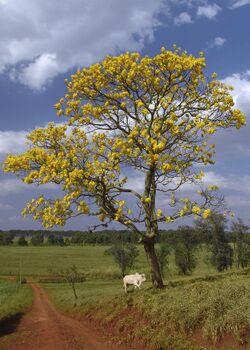Biology:Handroanthus chrysotrichus
| Handroanthus chrysotrichus | |
|---|---|

| |
| Scientific classification | |
| Kingdom: | Plantae |
| Clade: | Tracheophytes |
| Clade: | Angiosperms |
| Clade: | Eudicots |
| Clade: | Asterids |
| Order: | Lamiales |
| Family: | Bignoniaceae |
| Genus: | Handroanthus |
| Species: | H. chrysotrichus
|
| Binomial name | |
| Handroanthus chrysotrichus (Mart. ex DC.) Mattos
| |
| Synonyms | |
|
Gelseminum chrysotrichum (Mart. ex A. DC.) Kuntze | |
Handroanthus chrysotrichus, synonym Tabebuia chrysotricha, commonly known as the golden trumpet tree, is a semi-evergreen/semi-deciduous (shedding foliage for a short period in late spring)[1] tree from Brazil. It is very similar to and often confused with Tabebuia ochracea. In Portuguese it is called ipê amarelo and its flower is considered the national flower of Brazil.
Growth
Handroanthus chrysotrichus grows to a height of 5 to 8 m (15 to 25 ft), sometimes up to 20 m (50 ft),[1] with a spread of 8 to 11 m (25 to 35 ft). It has very showy golden-yellow to red flowers in the spring. These are rich in nectar and thus the tree is a useful honey plant. While it is not especially popular with hummingbirds, some of these – e.g. glittering-bellied emerald (Chlorostilbon lucidus) and white-throated hummingbird (Leucochloris albicollis) – seem to prefer them over the flowers of other Tabebuia species.[2]
The golden trumpet tree is grown outside Brazil as a street tree and garden tree. The USDA rates it for hardiness zones 9b through 11, and moderately drought-tolerant.
Concern has been raised that it is becoming a weed in tropical and sub-tropical Australia, though it has not yet been declared.[3]
Taxonomy
A 2007 DNA study of various members classified in the genus Tabebuia showed that the taxon was polyphyletic, and two genera were resurrected to separate these members into three separate clades: Roseodendron, Handroanthus, and Tabebuia.[4] Tabebuia chrysotricha was moved to Handroanthus chrysotrichus, characterized by the hardness of its wood and high lapachol content.[4]
Gallery
References
- ↑ 1.0 1.1 Gilman, Edward F.; Watson, Dennis G. (21 March 2007). "ENH-772/ST614: Tabebuia chrysotricha: Golden Trumpet Tree". University of Florida. http://edis.ifas.ufl.edu/st614.
- ↑ Baza Mendonça & dos Anjos (2005)
- ↑ Technigro Australia Pty. Ltd (2013)
- ↑ 4.0 4.1 Susan O. Grose and R. G. Olmstead
Further reading
- Baza Mendonça, Luciana & dos Anjos, Luiz (2005): Beija-flores (Aves, Trochilidae) e seus recursos florais em uma área urbana do Sul do Brasil [Hummingbirds (Aves, Trochilidae) and their flowers in an urban area of southern Brazil]. [Portuguese with English abstract] Revista Brasileira de Zoologia 22(1): 51–59. doi:10.1590/S0101-81752005000100007 PDF fulltext
- Susan O. Grose and R. G. Olmstead (2007): Taxonomic Revisions in the Polyphyletic Genus Tabebuia s. l. (Bignoniaceae). Systematic Botany "32"(3):660-670. doi:10.1600/036364407782250652 abstract
- Technigro Australia Pty. Ltd. (2013): Weed Watch: Golden Trumpet Tree Tabebuia Chrysotricha http://www.technigro.com.au/documents/GoldenTrumpetTree.pdf
External links
- Tabebuia chrysotricha, Golden Trumpet Tree
- Tabebuia chrysotricha / Handroanthus chrysotrichus (Yellow trumpet tree) - JCU
- Tabebuia chrysotricha - Golden Trumpet Tree - Plant Finder- Sunset.com
- http://www.bioone.org/doi/abs/10.1600/036364407782250652
Wikidata ☰ Q15548105 entry
 |




